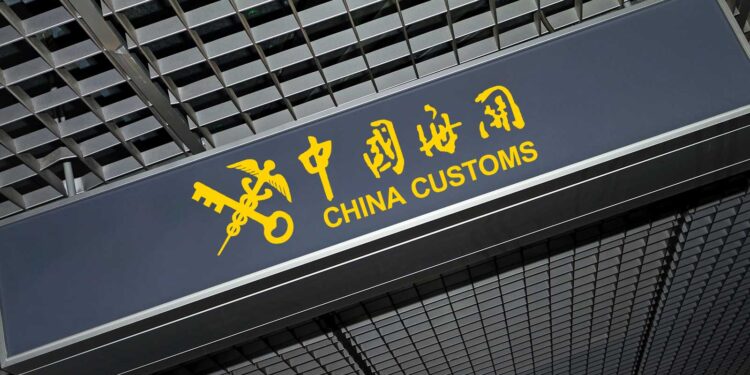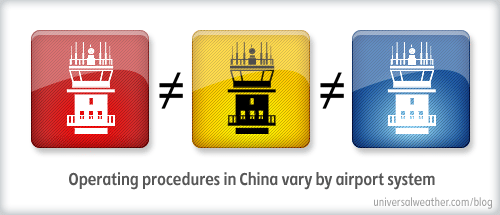10 Must-Knows About Airport Operations and Customs When Flying into China

This business aviation blog post is the first part in a series on operating to China.
While China is a unique operating environment in terms of airport operations, ground handling and clearing Customs, Immigrations and Quarantine (CIQ), operators seldom experience problems. Your 3rd-party provider and local ground handler can help you ensure a timely and smooth process. Take the time to research your particular destinations, as airport and CIQ procedures can vary from airport to airport.
1. Be alert to airport operating characteristics in China
There are airports in China that have QFE approaches, so your altitude will read “zero” when you land. Flight crews need to be aware of additional preparations. Keep in mind that you may not have a choice in selection of airports at Shanghai. Hongqiao (ZSSS) has a new Fixed Base Operator (FBO). While it’s closer to the city center, it’s not always usable. Access will depend on your itinerary. If you’re inbound to Shanghai from the east or outbound from Shanghai towards the east, you’ll almost always be required to use Pudong (ZSPD) due to airspace conflicts.

Diagram of flight levels allocation for China. (Source: General Administration of Civil Aviation of China (CAAC), 2007-10-15)
2. Keep to approved slot times as closely as possible
Depending on the time of day and volume of traffic, changing a slot at Beijing (ZBAA) or Shanghai (ZSPD or ZSSS) can be difficult. It’s always best to remind your passengers to arrive at the airport on time. We recommend giving Air Traffic Control (ATC) at least a 30-minute window on your expected arrival or departure. You may be allowed more time if you can give ATC a valid reason. If you’re delayed by two hours or more, call your ground handler. He or she will have to negotiate with ATC. Also, a 3rd-party provider can help you avoid issues arising from delays.
3. Customs procedures differ airport to airport
How passengers get in and out of airports and CIQ will vary from airport to airport. At major cities – such as Shanghai (ZSPD or ZSSS) and Beijing (ZBAA) – passengers may have use of an FBO or VIP terminal. In more remote locations, you’ll use a VIP terminal or the general terminal to clear CIQ. With prior notice, arrangements can be made to escort passengers and crew through customs – often with a dedicated CIQ lane opened. At some locations, a quarantine official may come aboard the aircraft to conduct a temperature scan of the crew and passengers upon arrival.

At Beijing (ZBAA), you’ll taxi to the ramp area – often right in front of the FBO, if parking space is available. Once the CIQ official gives the signal to open the cabin door, an immigration officer will board the plane to collect all passports. A quarantine officer may or may not board the aircraft (the officer will advise at the last minute). After all the passengers have disembarked, customs may board the airplane for visual inspection. Then, passengers and their luggage will be transported to Terminal 2, where a designated customs/immigration office is located to finish the CIQ process. Depending on the customs official, all carryon bags and luggage may need to be scanned by an X-ray machine at the customs office.
Once the CIQ process is completed, all passengers and their luggage will then be shuttled to the FBO lounge, where the ground handling agent escorts them to their receiving party. Meanwhile, the passengers’ vehicles are coordinated outside the FBO. Crew will then clear CIQ via the same process. The entire CIQ process may take between 30 and 60 minutes.
4. Issues may arise if you aren’t using a qualified ground handler
You may experience delays or other problems if you don’t have proper ground handling arrangements. This includes missing ground transportation, delayed fuel or lavatory service, delays with CIQ clearance and incorrect in-flight catering orders. Using an experienced ground handler and 3rd-party provider can help ensure that your operations in China go very smoothly.
5. Obtaining correct crew visas continues to be a challenge for operators to China
Generally, all crew members operating to or from China will require a “C”-type crew visa. However, crew members may enter China with different types of visas for the following locations and with prior arrangements by your 3rd-party:
- ZBAA – Beijing Capital International Airport
- ZGGG – Guangzhou Baiyun International Airport
- ZGSZ – Shenzhen Bao’an International Airport
For passengers, all visas are valid except for “C”-type visas. If crew members arrive in China without the correct crew visas, the result can be a fine or deportation. Multi-entry crew visas are obtainable, and, in some cases, annual China crew visas are available. Multi-entry visas are based on your need of operations. You must show a multi-operation schedule, state your reasons on company letterhead or prove that you need to enter China more than once.
Added 8 February 2012: G3Visas has provided some additional insight into C-type visas in China. See the comments section below for more details. We always recommend that you contact your visa provider to obtain the latest information on Chinese visas prior to your trip.
Added 29 February 2012: G3Visas has advised that the Chinese government is enforcing strict new visa regulations. See the comments section below for more details. We always recommend that you contact your visa provider to obtain the latest information on Chinese visas prior to your trip.
Added 2 January 2013: There is a new immigration policy that went into effect on 1 January, 2013 for transit passengers. Specifically, for citizens from 45 countries (see list below) who transit from Shanghai Pudong Airport (ZSPD) or Hongqiao Airport (ZSSS) or to Beijing Airport (ZBAA) to a third country, can stay in Shanghai or Beijing Administrative Region for up to 72 hours without a visa under the new regulations.
Asia: South Korea, Japan, Singapore, Brunei, United Arab Emirates, Qatar.
Oceania: Australia, New Zealand.
Europe: Austria, Belgium, Czech Republic, Denmark, Estonia, Finland, France, Germany, Greece, Hungary, Iceland, Italy, Latvia, Lithuania, Luxembourg, Malta, Netherlands, Poland, Portugal, Slovakia, Slovenia, Spain, Sweden, Switzerland, Russia, United Kingdom, Ireland, Cyprus, Bulgaria, Romania, Ukraine.
America: United States, Canada, Brazil, Mexico, Argentina, Chile.
Furthermore, a crew member may not arrive or depart China with a crew visa as a passenger on a commercial flight. So, if you are flying to China commercially to pick up your corporate aircraft, you’ll require either a tourist or business visa on arrival and a crew visa on departure. Keep in mind that a crew visa is usually only valid for seven days in country. If you plan to stay longer, you may have to depart China and fly to Hong Kong to renew your crew visa and obtain a tourist visa to re-enter China. Correct visa type is a critical issue in China and continues to create issues for many operators.
Certain nationalities – including Russians and Japanese – may obtain visas on arrival at several selected cities in China, including Beijing and Shanghai. However, this privilege is not available to U.S. citizens or those of many other nationalities.
We recommend you contact your visa provider to obtain the most up-to-date information, as visa requirements may change at a moment’s notice.
6. What are the different type of visa and visa validities?
The ordinary visas consist of nine sub-categories marked with Chinese phonetic letters (D, Z, X, F, L, G, C, J-1 and J-2 respectively).
- Visa D: Issued to aliens who are to reside permanently in China. A permanent residence confirmation form shall be required for the application of Visa D. The applicant shall apply to obtain this form himself or through his designated relatives in China from the exit-and-entry department of the public security bureau in the city or county where he applies to reside.
- Visa Z: Issued to aliens who are to take up posts or employment in China, and to their accompanying family members. To apply for a Visa Z, an Employment License of the People’s Republic of China for Foreigners (which could be obtained by the employer in China from the provincial or municipal labor authorities) and a visa notification letter/telegram issued by an authorized organization or company are required.
- Visa X: Issued to aliens who come to China for study, advanced studies or job-training for a period of six months or more. To apply for a Visa X, certificates from the receiving unit and the competent authority concerned are required, i.e., Application Form for Overseas Students to China (JW201 Form or JW202 Form), Admission Notice and Physical Examination Record for Foreigners.
- Visa F: Issued to an applicant who is invited to China on a visit, on a study or lecture, business tour, for scientific-technological and cultural exchanges, for short-term refresher course or for job-training, for a period of no more than six months. To apply for a Visa F, the invitation letter from the inviting unit or the visa notification letter/telegram from the authorized unit is required.
- Visa L: Issued to aliens who come to China for sightseeing, visiting relatives or other private purposes. For a tourist applicant, in principle he shall evidence his financial capability of covering the traveling expenses in China, and when necessary, provide the air, train or ship tickets to the heading country/region after leaving China. For the applicants who come to China to visit relatives, some are required to provide invitation letters from their relatives in China.
- Visa G: Issued to aliens who transit through China. The applicants are required to show valid visas and on-going tickets to the heading countries/regions.
- Visa C: Issued to train attendants, air crew members and seamen operating international services, and to their accompanying family members. To apply for a visa C, relevant documents are required to be provided in accordance with bilateral agreements or regulations of the Chinese side.
- Visa J-1: Issued to foreign resident correspondents in China.
- Visa J-2: Issued to foreign correspondents who make short trip to China on reporting tasks. The applicants for J-1 and J-2 visas are required to provide a certificate issued by the competent Chinese authorities.
7. Always have your local agent onsite
If there are issues on arrival, your local ground handling agent can often remedy the situation. Challenging local authorities is never recommended, but the ground handler can attempt to negotiate expedited service or perhaps reduced penalties. For this reason, it’s best practice to have a ground handling agent onsite well before your arrival. Also, with prior notice, ground handling agents may be repositioned to remote airport locations when required.
8. FBOs may operate differently in China
An FBO or General Aviation Terminal (GAT) in China may have the appearance of an airline terminal. However, services are generally excellent, and new FBOs and GATs continue to open across the country. In early 2011, a new FBO opened at Shenzhen (ZGSZ), and we expect corporate aviation infrastructure expansion to continue to improve.
9. Always double-check that general declarations are correct
Operators may occasionally encounter problems with general declarations when the correct passenger count isn’t indicated on the form. This may cause delays, as paperwork will have to be re-submitted to the local authorities.
10. Cabotage not allowed in China
Cabotage is not permitted in China by regulation. However, it may be possible to make local arrangements with all the airports to ensure ground handling is smooth for all passengers. It’s recommended that you contact your 3rd-party provider or ground handler to obtain more information.
Questions?
If you have any questions about this article or would like assistance planning your next trip to China, contact Christine Vamvakas christinevamvakas@univ-wea.com.
Later we will discuss tips for arranging aircraft ground handling and fueling in China.




